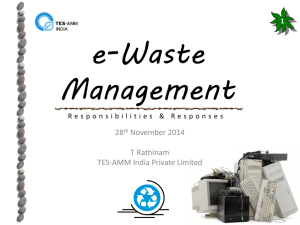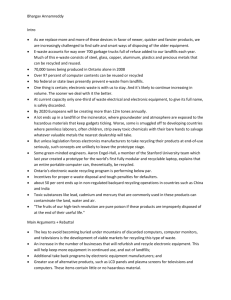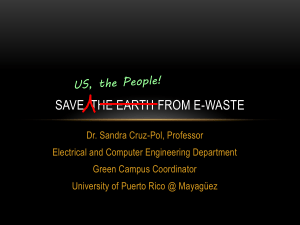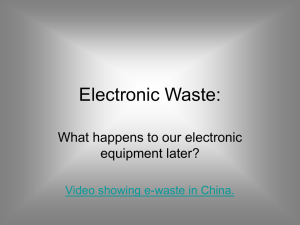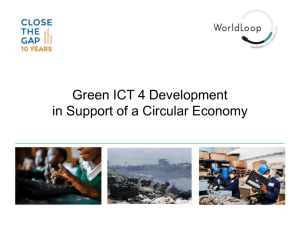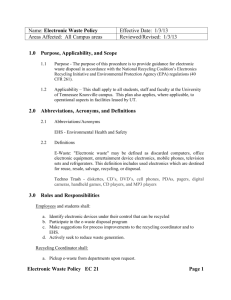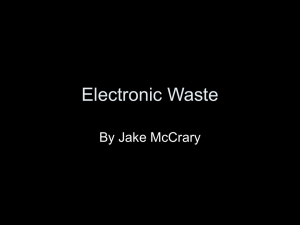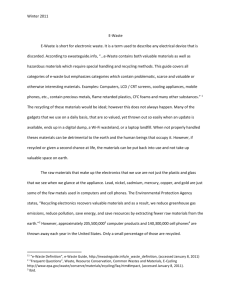Caring for our Community ~ Recycling e-Waste
advertisement
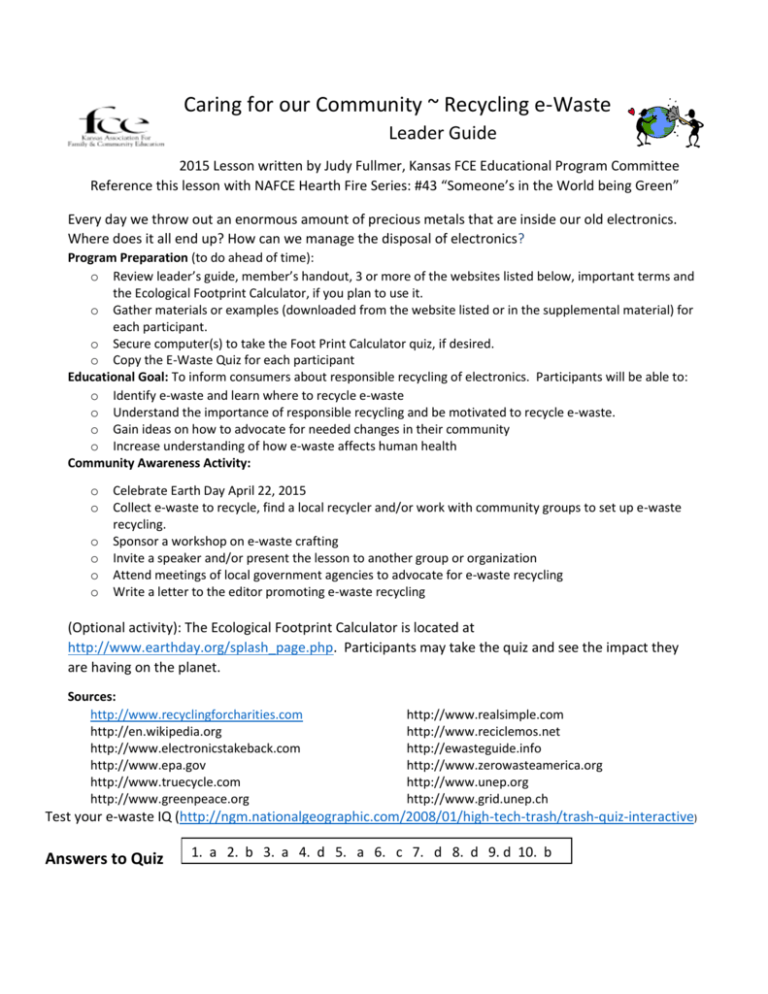
Caring for our Community ~ Recycling e-Waste Leader Guide 2015 Lesson written by Judy Fullmer, Kansas FCE Educational Program Committee Reference this lesson with NAFCE Hearth Fire Series: #43 “Someone’s in the World being Green” Every day we throw out an enormous amount of precious metals that are inside our old electronics. Where does it all end up? How can we manage the disposal of electronics? Program Preparation (to do ahead of time): o Review leader’s guide, member’s handout, 3 or more of the websites listed below, important terms and the Ecological Footprint Calculator, if you plan to use it. o Gather materials or examples (downloaded from the website listed or in the supplemental material) for each participant. o Secure computer(s) to take the Foot Print Calculator quiz, if desired. o Copy the E-Waste Quiz for each participant Educational Goal: To inform consumers about responsible recycling of electronics. Participants will be able to: o Identify e-waste and learn where to recycle e-waste o Understand the importance of responsible recycling and be motivated to recycle e-waste. o Gain ideas on how to advocate for needed changes in their community o Increase understanding of how e-waste affects human health Community Awareness Activity: o o o o o o Celebrate Earth Day April 22, 2015 Collect e-waste to recycle, find a local recycler and/or work with community groups to set up e-waste recycling. Sponsor a workshop on e-waste crafting Invite a speaker and/or present the lesson to another group or organization Attend meetings of local government agencies to advocate for e-waste recycling Write a letter to the editor promoting e-waste recycling (Optional activity): The Ecological Footprint Calculator is located at http://www.earthday.org/splash_page.php. Participants may take the quiz and see the impact they are having on the planet. Sources: http://www.recyclingforcharities.com http://en.wikipedia.org http://www.electronicstakeback.com http://www.epa.gov http://www.truecycle.com http://www.greenpeace.org http://www.realsimple.com http://www.reciclemos.net http://ewasteguide.info http://www.zerowasteamerica.org http://www.unep.org http://www.grid.unep.ch Test your e-waste IQ (http://ngm.nationalgeographic.com/2008/01/high-tech-trash/trash-quiz-interactive) Answers to Quiz 1. a 2. b 3. a 4. d 5. a 6. c 7. d 8. d 9. d 10. b E-Waste Quiz 1. What makes the circuit board one of the most sought after pieces of e-waste? a) Contains metal with commercial value b) Readily available. c) Easiest to work with. d) Contains no toxic components. 2. In 1965 Gordon Moore, Intel cofounder, made a prediction about the future of computer processing. What does his “Moore’s Law” prediction say? a) As technology continues to advance, the computer microchip will become obsolete. b) Computer-processing power will double every 18 months to 2 years. c) There will eventually be no need for transistors in high-tech electronics. d) As the number of transistors increases, computer-processing power will be cut in half every 2 years. 3. CompuMentor, a Californian nonprofit, found that while you can recycle an old computer, it’s 20 times more energy efficient to a) Refurbish it for reuse b) Dismantle it. c) Place it in storage. d) Ship it to another country. 4. What is a common reason people or companies give for not reusing or recycling their electronics? a) Government restrictions b) No usable value. c) Lack of recycling facilities. d) Data security. 5. The Basel Action Network’s 2002 film Exporting Harm revealed the hazards of ewaste processing by residents of Guiyu in China’s Guandong Province. How have Guiyu residents’ practices affected others on a global scale? a) Contributed to continuing toxic product manufacture. b) Eliminated the exporting of toxic e-waste. c) Allowed other countries to safely and legally dispose of e-waste. d) Opened up a profitable market. 6. The Basel Convention of 1989 requires developed nations alert developing nations to incoming hazardous waste shipments. The 1995 Basel Ban Amendment forbids sending hazardous waste to poor countries. Which nations, or group of nations, currently serve as models for enforcing these policies? a) United States b) Australia c) European Union d) China 7. What happens to most of the electronic waste sent to recyclers in the United States? a) It’s recycled efficiently. b) It’s reconditioned for reuse. c) It’s sent to illegitimate recycling firms. d) It’s exported. 8. Which of the following should you consider when trying to purchase environmentally friendly products? a) Use of minimal packaging. b) Products designed for easy upgrade or disassembly c) Products that offer leasing or take back options. d) All of the above. 9. In the U.S. e-waste recycling programs can also be found in a) State Parks b) NASA Facilities c) Prisons d) Public Schools 10. As high definition television (HDTV) becomes increasingly popular, which hazardous component of some electronics is likely to become more common in high tech trash? a) Circuit Board b) Cathode ray tubes. c) Copper wire d) Plastics.



